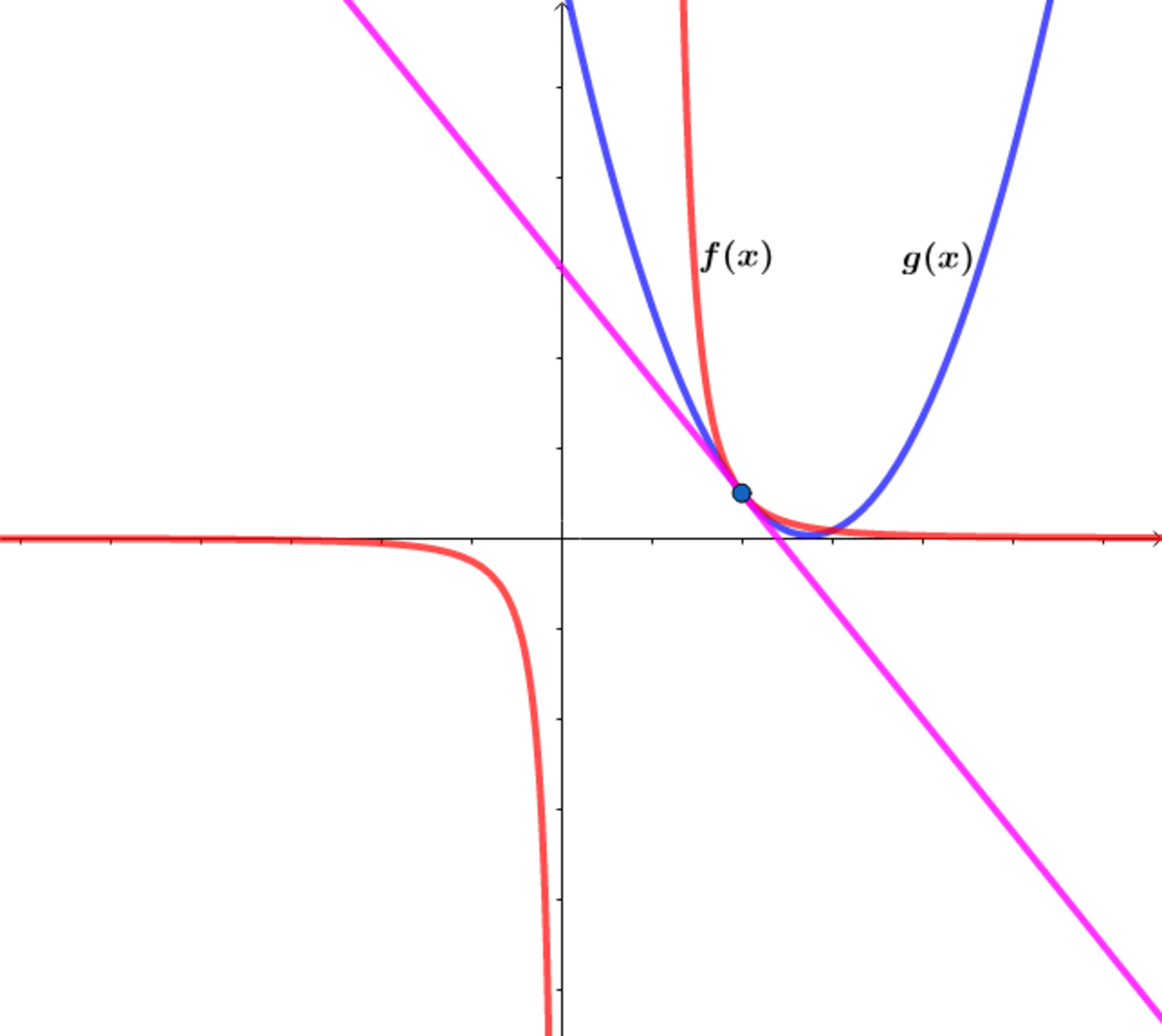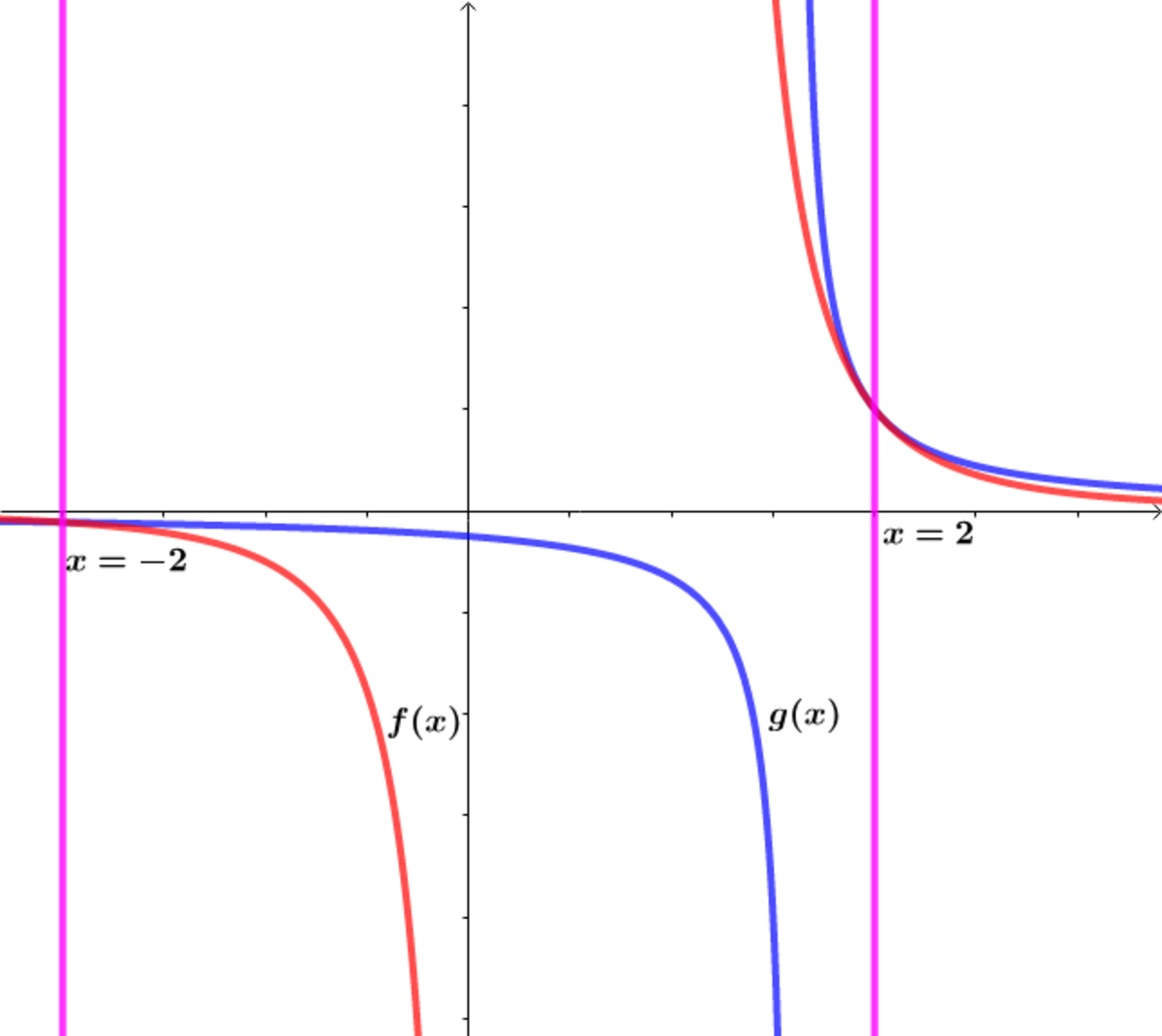Common Tangent Mania

Let β be a positive integer and ∣ x ∣ > 1 and f ( x ) = ∑ j = 0 ∞ ( x β + j + 1 − x β + j 1 ) and g ( x ) = a x 2 + b x + c .
If f ( 3 ) = g ( 3 ) and f ( x ) and g ( x ) have a common tangent at x = 2 and a + b + c = α α ∗ λ β − w 1 + α β − w β + λ , where α , λ and w are coprime positive integers, find α + λ + w .
I used β = 2 for the above graph.
The answer is 6.
This section requires Javascript.
You are seeing this because something didn't load right. We suggest you, (a) try
refreshing the page, (b) enabling javascript if it is disabled on your browser and,
finally, (c)
loading the
non-javascript version of this page
. We're sorry about the hassle.
1 solution
where did you get this problem
Log in to reply
I created it.
When I create a problem I usually have an idea and then I see how it works out. For this problem I first did it for β = 2 , then I decided to generalize it for any positive integer β .
I recently posted a similar problem for β = 2 below:

Let ∣ x ∣ > 1 .
Let f ( x ) = ∑ n = 0 ∞ x 3 + n − x 2 + n 1 and g ( x ) = a x + b 1 .
If g ( 2 ) = f ( 2 ) and g ( − 2 ) = f ( − 2 ) and V 1 is the volume of the region bounded by the two curves f ( x ) and g ( x ) on [ 2 , ∞ ) when revolved about the x -axis and V 2 is the volume of the region bounded by the two curves f ( x ) and g ( x ) on ( − ∞ , − 2 ] when revolved about the x -axis, find V 1 + V 2 to eight decimal places.
Unfortunately, since it involved partial fractions I could not generalize it for any positive integer β .
For β ∈ N and ∣ x ∣ > 1 .
f ( x ) = ∑ n = 0 ∞ x β + n + 1 − x β + n 1 = x β ( x − 1 ) 1 ∑ 0 ∞ ( x 1 ) n = x β − 1 ( x − 1 ) 2 1
Let g ( x ) = a x 2 + b x + c .
f ( 3 ) = g ( 3 ) ⟹ 9 a + 3 b + c = 4 ∗ 3 β − 1 1
f ( x ) and g ( x ) have a common tangent at x = 2 ⟹ f ( 2 ) = g ( 2 ) and d x d ( f ( x ) ) ∣ x = 2 = d x d ( g ( x ) ) ∣ x = 2 .
f ( 2 ) = g ( 2 ) ⟹ 4 a + 2 b + c = 2 β − 1 1
d x d ( f ( x ) ) = x β ( x − 1 ) 3 β − 1 − ( β + 1 ) x and d x d ( g ( x ) ) = 2 a x + b .
d x d ( f ( x ) ) ∣ x = 2 = d x d ( g ( x ) ) ∣ x = 2 ⟹ 4 a + b = − 2 β β + 3
Solving the system
4 a + 2 b + c = 2 β − 1 1
9 a + 3 b + c = 4 ∗ 3 β − 1 1
4 a + b = − 2 β β + 3
we obtain:
5 a + b = 4 ∗ 3 β − 1 1 − 2 β − 1 1
4 a + b = − 2 β β + 3
⟹ a = 4 ∗ 3 β − 1 1 − 2 β − 1 1 + 2 β β + 3
b = − 3 β − 1 1 + 2 β − 1 4 − 2 β 5 ( β + 3 )
c = 3 β − 1 1 − 2 β − 1 3 + 2 β 6 ( β + 3 )
⟹ a + b + c = 4 ∗ 3 β − 1 1 + 2 β − 1 β + 3 = 2 2 ∗ 3 β − 1 1 + 2 β − 1 β + 3 = α α ∗ λ β − w 1 + α β − w β + λ
⟹ α + λ + w = 6
The common tangent at ( 2 , 2 β − 1 1 ) is: 2 β y + ( β + 3 ) x = 2 β + 8 .
Note: For β = 2 ⟹ a = 6 5 , b = − 1 2 5 5 and c = 3 1 9 ⟹ g ( x ) = 1 2 1 ( 1 0 x 2 − 5 5 x + 7 6 ) and a + b + c = 1 2 3 1 .
The graph below shows f β ( x ) and g β ( x ) for β = 3 .
For β = 3 ⟹ a = 3 6 1 9 , b = 3 6 − 1 0 3 and c = 3 6 1 3 9 ⟹ g ( x ) = 7 2 1 ( 3 8 x 2 − 2 0 6 x + 2 7 8 ) and a + b + c = 3 6 5 5 .